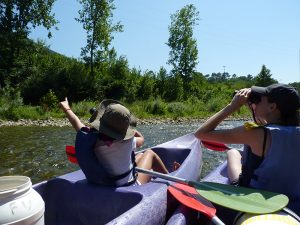Welcome to the captivating life of the bearded vulture, one of the most impressive birds gliding through our skies. Its wingspan and elegances take us to explore their fascinating biology and behavior. Are you ready for this journey to the kingdom of heights?
Bearded vulture in shorts
*Scientific name: Gypaetus barbatus.
*Distribution in the world: Europa mountains, Asia, Africa and Middle East.
*Distribution in Spain: Pyrenees, Picos de Europa, Cazorla, Sierra Nevada and Gredos
*Conservation Status: Vulnerable species in Spain, according to the Red Book of Birds in Spain, 2021.
Details on the great glider

Size and wingspan
This bird does not go unnoticed in flight. With a wingspan up to 2.8m, bearded vulture truly is a giant in the sky. Easy to identify when flying thanks to its distinctive and unique silhouette: the diamond shaped tail and the way they glide, making the most of the air currents close to the great walls, make their flight unmistakable to any other raptor’s
Colourful plumage
Their plumage shows a combination of white, black and ochre. The head is crowned with erectile feathers that give it a regal appearance. The juveniles are very blackish and the adults, due to bathing in ferruginous water, acquire an orange colouring on the head and chest. If you are lucky to see a bearded vulture flying towards you, you will be able to clearly distinguish the head, as if it had a flashy tennis ball.
The Breaker Food Technique
In Spanish, bearded vulture is known as “quebrantahuesos”, Spanish for bone breaker. Although this name might suggest a ruthless, violent predator, nothing further from the truth. The Spanish name is given after the way they feed: they are osteophages, i.e., they feed on bones. They are the cleaners of the wild, removing the remains of carcasses after other species have feasted on the flesh. Griffon vultures, foxes, wolves, etc. feed on carrion, leaving the bones, and the bearded vulture fills the gap so as not to compete for food. It grabs a bone, flies high enough and drops it on a rock, breaking it into smaller pieces, which it then swallows, whole!
Nuptial flights and mating
When winter comes and cold gets harder, when other species hibernate in burrows or migrate to warmer regions, bearded vulture gets on heat: it’s time to mate and build the nest. It attracts attention with acrobatic flights and demonstrations of its aerial skills. Not only pairs, but sometimes trios and even quartets are formed, thus ensuring protection and food for the chick. The young bird spends a long time in the nest, more than three months, before it is able to fly.
Conservation Programs
Because of the uncontrolled use of poisons and shotguns in Spain, this species has been disappearing, and its population has been reduced only to the Pyrenees. In recent years, thanks to reintroduction projects, they have managed to return and breed in Cazorla. The Foundation for the Conservation of the Bearded Vulture (FCQ) has been working for more than 10 years on the reintroduction of the Bearded Vulture in the Picos de Europa. The result of their impressive work has allowed these vultures to breed again in Picos de Europa: in 2020 the first chick in the wild in 70 years was born, quite an achievement! Currently there are already 3 chicks born in the countryside of this protected area of Picos de Europa. They have also proceeded to the reintroduction of the species in Gredos, where there are still a few years left to get them to breed.
Amazing facts

Heaven’s health staff
We have already learnt we don’t have to worry about them, despite their fierce name. In fact, we must be grateful: their bone-based feeding has huge ecological benefits, since they keep the ecosystem balanced avoiding the carcasses to spread infections and diseases. They are closely related to extensive farming of sheep and goats, taking away from the field the bone remains from dead animals in the mountains.
Mighty flights
Having the chance to enjoy the sight of these vultures gliding along the imponent rocky mountain walls and gorges is a real pleasure. To see how they ride the air streams, playing and looking for food is a complete delight. They can reach great heights: being able to breed in the high lands of the Himalayas gives us a hint about their amazing flying skills.
To put it in a nutshell, the bearded vulture is not just a bird of prey; it is a winged species that inspires admiration and respect. Its role in nature, its majestic flights and its peculiar feeding technique make this bird one of the jewels of the animal kingdom and it is an emblematic species in the Picos de Europa National Park.
If you want to learn more about the bearded vulture you can visit this website and, if you want to come and see it in Picos de Europa, you already know that you can contact us and enjoy this unique experience.



